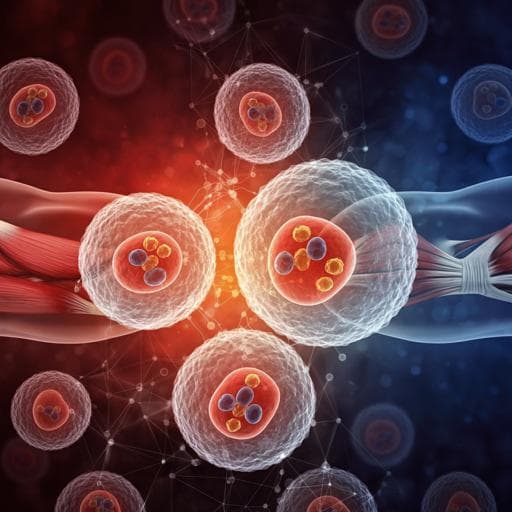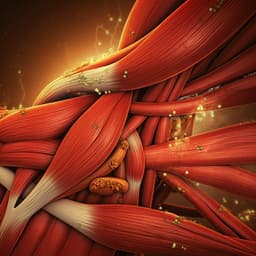
Health and Fitness
Acute and long-term exercise adaptation of adipose tissue and skeletal muscle in humans: a matched transcriptomics approach after 8-week training-intervention
S. I. Dreher, M. Irmler, et al.
This groundbreaking study explores how exercise uniquely affects subcutaneous adipose tissue (SCAT) and skeletal muscle in overweight individuals. Discover the fascinating acute and long-term adaptations that could revolutionize our understanding of fitness, conducted by authors including Simon I. Dreher and Martin Irmler.
~3 min • Beginner • English
Introduction
Type 2 diabetes (T2D) risk is driven largely by lifestyle, with excess energy intake and sedentary behavior leading to increased adiposity and reduced cardiorespiratory fitness. Regular physical activity reduces T2D risk and improves insulin sensitivity. While skeletal muscle (SM) adaptations to exercise are well characterized (e.g., increased mass, capillarization, mitochondrial content), subcutaneous adipose tissue (SCAT) also contributes to metabolic homeostasis and is linked to insulin resistance and T2D when dysregulated. Prior reports indicate endurance training improves SCAT insulin sensitivity and alters enzymes of lipolysis and oxidative phosphorylation. However, the transcriptomic response of human SCAT to acute and repeated exercise is less understood. The study aimed to characterize SCAT transcript changes to acute and long-term exercise and compare them with matched skeletal muscle from the same donors to elucidate distinct or shared adaptive mechanisms.
Literature Review
Previous studies showed endurance training improves insulin sensitivity in SCAT and increases abundance of enzymes related to lipolysis, glyceroneogenesis, and oxidative phosphorylation in trained versus untrained individuals. Long-term interventions have focused on potential changes in mitochondrial respiration and content in SCAT, with mixed results. Skeletal muscle exhibits pronounced transcriptomic and proteomic changes to acute exercise that drive adaptive processes. Limited data exist on SCAT transcriptomic responses to acute and repeated exercise, particularly in matched designs with skeletal muscle. The authors hypothesized that SCAT, though not directly utilized mechanically during exercise, acutely responds at the transcript level, paving the way for long-term effects on lipid metabolism and potentially mitochondrial function.
Methodology
Study participants: Healthy, sedentary (<120 min physical activity/week) adults at high T2D risk with at least one risk factor (BMI > 27 kg/m², first-degree family history of T2D, or prior gestational diabetes) were recruited. Of 25 participants in a prior analysis, 14 were included here (8 female/6 male). Informed consent obtained; ethics approval from University of Tübingen. Registered at ClinicalTrials.gov (NCT03151590).
Study design: 8-week supervised endurance training, 3 sessions/week, each 1 hour (30 min cycling + 30 min treadmill walking) at 80% of baseline VO₂peak. VO₂peak determined by maximal incremental cycling test. Training intensity controlled by heart rate reflecting 80% VO₂peak.
Phenotyping: Anthropometry, metabolic parameters, and cardiorespiratory fitness assessed. Whole-body and regional adipose tissue measured by MRI; SCAT volume quantified from femoral heads to humeri.
Biopsies: Abdominal SCAT obtained lateral to the umbilicus via Menghini needle; vastus lateralis muscle via Bergström needle. Biopsies collected at four time points: Baseline (resting, 8 days before training), Untrained Acute (60 min after first exercise bout), Trained Acute (60 min after last exercise bout), and Trained (resting, 5 days post-intervention). Resting biopsies were taken 60 min after an OGTT; for acute bouts, a standardized breakfast was provided 45 min before exercise to parallel post-OGTT hormonal milieu. All biopsies at 11:00 am ± 30 min.
Transcriptomics: High-quality RNA (RIN > 7) extracted (Trifast/miRNeasy for adipose; miRNeasy for muscle), amplified (WT PLUS Reagent Kit), hybridized on Human Clariom S arrays, scanned on GeneChip Scanner 3000 7G. Quality control and SST-RMA normalization in TAC v4.0. Data in GEO (GSE208032, GSE161750, GSE161749; overall dataset availability GSE224310). Available sample sizes: Baseline n=11, Untrained Acute n=10, Trained Acute n=13, Trained n=12; n=6 had all time points. Matched comparisons: acute untrained n=8; training effects n=9. Differential expression assessed using limma; FDR controlled by Benjamini–Hochberg; primary thresholds FC ≥ 1.2 and FDR < 10% (or p < 0.01 where indicated). Enrichment and upstream regulator analyses performed (including Ingenuity Pathway Analysis).
High-resolution respirometry: Oroboros Oxygraph-2k used to assess mitochondrial respiration in SCAT and SM before and after training (subset n=14), with substrates and protocol per prior publication. Metrics normalized to tissue mass.
Circadian integration: To relate exercise-regulated transcripts to circadian patterns, SCAT expression data were integrated with the CLOCK study dataset (NCT02487576) that profiled SCAT at 3 time points across the day in men (n=15). Circadian parameters and peak times estimated using a three-time-point rhythm prediction method with magnitude correction.
Statistics: Limma for transcriptomics; one-way ANOVA with Tukey correction for selected gene expression comparisons; Fisher’s LSD for respirometry post hoc tests; significance thresholds as specified in figure legends and text.
Key Findings
- Acute SCAT response: 37 transcripts significantly regulated 60 min after the first exercise bout (FC ≥ 1.2; FDR < 10%); 28 down-regulated and 9 up-regulated. Enrichment pointed to decreased lipid uptake, storage, and de novo lipogenesis pathways (e.g., PPAR/SREBP-related terms) and involvement of circadian clock/rhythm genes.
- Specific genes in SCAT (acute): Significant reductions in transcripts related to lipogenesis and lipid storage, including AACS, ACACA, GPAM, INSIG1, IRS1, LDLR, MID1IP1, PNPLA3, PPARG, and SREBF1; ELOVL6 and FASN trended lower. ANGPTL4 (LPL inhibitor) increased, while ANGPTL8 (ANGPTL4 suppressor) decreased, suggesting reduced lipid uptake/storage.
- Upstream analysis (SCAT, acute): Predicted inhibition of SREBF1/2, insulin, and AKT signaling; activation of INSIG1/2 feedback; activation of β-adrenergic receptor signaling consistent with catecholamine effects. Hints of acute anti-inflammatory signaling (inhibited TNF/PDGF).
- SCAT training adaptation (resting, 5 days post): Under strict FDR < 10%, only SMAD7 reduced; at p < 0.01, 209 DE transcripts (115 down, 94 up), enriched for circadian rhythm genes; upstream analysis suggested long-term anti-inflammatory adaptation (inhibited TGFB1, PDGF, TNF, IFNG; activated IL10RA).
- Circadian modulation in SCAT: Core clock genes CLOCK and ARNTL/BMAL1 were not altered at 11:00 sampling, but repressors PER1, PER2, CRY2, and NR1D1 were higher post-acute exercise; BHLHE40/41 and RAI1 were lower and CIART higher after acute exercise; BHLHE40/41 also reduced at rest after training. Integration with circadian dataset indicated many lipid metabolism genes (AACS, ELOVL6, INSIG1, IRS1, MID1IP1, SREBF1, PDK4) exhibit circadian expression, with exercise potentially altering amplitude/phase.
- Skeletal muscle acute response: 394 transcripts significantly regulated (FC ≥ 1.2; FDR < 10%), predominantly up-regulated (255 up, 139 down). Only 5 transcripts overlapped with SCAT acutely; just 2 in the same direction (PDK4 up; MYLIP down). Muscle upstream analysis indicated activation of SREBF1, PPARG, PPARGC1A (PGC1α), VEGF, HIF1A, among others.
- Skeletal muscle training adaptation (rest): At p < 0.01, 365 DE transcripts (257 up, 108 down). Only 11 genes overlapped with SCAT training response (9 same direction). Muscle upstream regulators pointed to cell growth, hypertrophy, and ECM remodeling.
- Mitochondrial adaptations: PGC1α (PPARGC1A) markedly induced acutely in muscle, not in SCAT. Mitochondrial respiration increased in skeletal muscle after training; SCAT respiration unchanged.
- Browning markers in SCAT: No evidence for beigeing/browning after training; UCP1 and PRDM16 unchanged; CIDEA tended to be acutely elevated, potentially reflecting circadian effects rather than browning.
- Overall: SCAT exhibits a distinct, largely non-overlapping transcriptional response to exercise compared with skeletal muscle, characterized acutely by suppression of lipid storage/lipogenesis programs and modulation of circadian genes; long-term by anti-inflammatory signatures without increased mitochondrial respiration.
Discussion
The study addressed whether human SCAT responds to acute and repeated exercise and how these responses compare to skeletal muscle. Findings demonstrate that SCAT, although not directly mechanically engaged during exercise, exhibits rapid transcriptomic changes. Acutely, SCAT down-regulates lipid uptake and lipogenesis pathways and modulates circadian clock components, suggesting catecholamine-driven β-adrenergic signaling and reduced insulin/AKT/SREBF activity. Repeated bouts likely reinforce these patterns and contribute to reduced SCAT volume observed previously, while long-term resting adaptations highlight an anti-inflammatory shift. In contrast, skeletal muscle shows robust activation of genes promoting substrate storage/oxidation, angiogenesis, and mitochondrial biogenesis, with increased respiration. The minimal overlap between tissues underscores tissue-specific regulation and distinct roles in systemic metabolic adaptation. Modulation of circadian rhythm in SCAT may restore healthier rhythmicity in individuals with overweight/obesity, potentially improving metabolic control and aiding T2D prevention. Lack of SCAT browning and mitochondrial respiration changes aligns with much of the human literature, contrasting rodent studies potentially confounded by housing temperature.
Conclusion
Adipose tissue adapts to exercise in a manner distinct from skeletal muscle. SCAT shows acute and repeated reductions in transcripts governing lipid uptake, synthesis, and storage, alongside modulation of circadian rhythm, and displays a long-term anti-inflammatory shift without increased mitochondrial respiration or browning. These adaptations may contribute to systemic metabolic improvements and T2D prevention. The findings highlight lipid metabolism and circadian pathways, and β-adrenergic signaling as potential mediators of SCAT responses, motivating future work to define mechanisms and translational targets.
Limitations
- Predominant focus on transcriptomics without proteomic validation; functional translation to protein level inferred but not directly measured.
- Timing of the post-training resting biopsy (5 days after last session) may miss transient transcript-level changes; no same-day pre-exercise resting biopsy.
- Limited sample size (n=14 total; n=6 with all time points) and feasible number of biopsies/time points; limits power and generalizability.
- No parallel non-training control group to distinguish training effects from temporal factors.
- Cohort restricted to individuals with overweight/obesity; responses may differ in lean individuals.
- Potential delayed SCAT response relative to skeletal muscle cannot be resolved with a single acute time point (60 min post-exercise).
Related Publications
Explore these studies to deepen your understanding of the subject.







